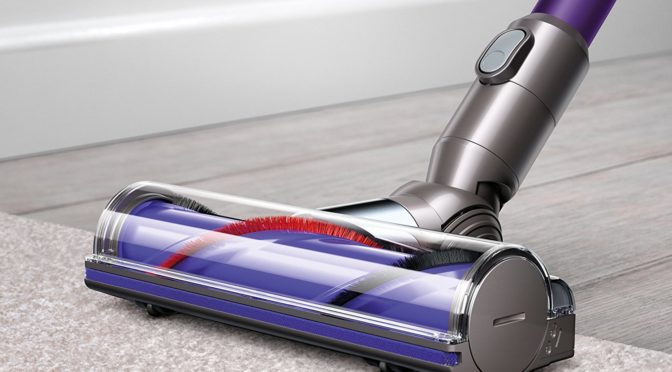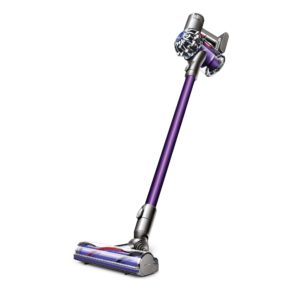
Sometimes in life, convenience is more important than completeness. If you’ve ever checked your email on a smart phone instead of on a laptop or desktop, you get it. It’s no different with vacuums; while you’re going to get a deeper, more thorough cleaning job with an upright or canister than you will with a portable or robotic vacuum, sometimes you just want to get rid of the dog hair on the couch before company comes over. Life is busy, and quite often, good enough is, well, good enough.
Dyson gets this. They’re worth billions because they give people options. Want a full-sized upright? Have the Ball Animal 2. Only need a handheld? Say hello to the V7 Car+Boat. Want something in-between like a stick vacuum? The best out there’s the V8 Absolute, which we’ve reviewed and confirmed does a better job than any ultralight on the market so far. Today we’ll review a slightly older cordless vacuum, the Dyson V6 Animal Cord-Free Vacuum, and see how it compares to the current-generation V8 Animal in value. To summarize our thoughts in ten seconds, we’d suggest upgrading to the V8 for more suction, battery life, and HEPA filtration, and sticking to the V6 if you want a slightly lighter vacuum. Our full review is below, and you can buy the V6 Animal here.
Pros, Cons, and Key Features of the Dyson V6 Animal Cordless Vacuum
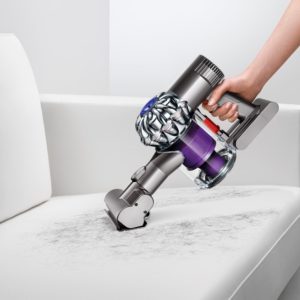
The Dyson V6 Animal is one of far-too many Dyson portables on the market today, and is a high-end model from two generations back. As a primer, Dyson calls their luxury portables “cordless” or “cord-free” vacuums and calls their stripped line “handheld.” The main differences are upgraded battery life in the cordless series as well as an extension hose that lets you use them as stick vacuums. The flagship cordless is the V8 Absolute and the flagship handheld is the V7 Car+Boat. Additional cordless-line vacuums include the V7 Motorhead, V6 Absolute, V6 Motorhead, and V6 Cord-Free.
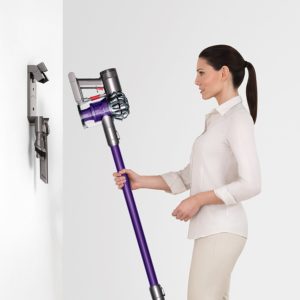
Key features for the V6 Animal include 20 minutes of battery life (which drops to 12 minutes with the direct driver cleaner head and drops to 6 minutes on max power mode), five cleaning tools, a wall-mounted charger, and Dyson’s 2 year warranty (which, by the way, doesn’t cover water damage, so keep the vacuum away from liquids). The V6 weighs 5 pounds on our scale and can generate 100 airwatts of suction. Its dust bin has a .11 gallon capacity and the fade-free Lithium-ion battery requires 3.5 hours to recharge.
Unboxing the Animal, you’ll find the vacuum and five cleaning tools–a direct drive cleaner head, which you’ll likely spend the most time using, a mini motorized tool, which is particularly useful in handheld mode, a mini soft dusting brush, a combination tool, and a crevice tool. You’ll also find the aforementioned charging and docking station.
What’s the difference between the Dyson V6 Animal and the V8 Animal?
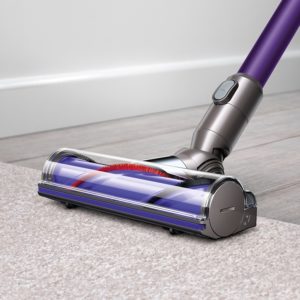
While the V6 and V8 Animals both belong to the same line, the two generations that separate them have led to a number of improvements that make an upgrade worth considering from the V6 to the V8. Alternatively, if you haven’t bought either and are deciding between the two, we’d strongly encourage considering the V8 due to advances in battery life, suction, and HEPA filtration. Let’s look at these factors more closely.
First, the battery upgrade is huge. You get 20 minutes with the V6, but you’ll get 40 minutes, or a 100% increase, with the V8. Practically speaking, this was the difference between vacuuming a bedroom and vacuuming the bedroom, the minivan, and a flight of stairs–in other words, highly significant. We also saw the difference when using the motorized head, which yielded 25 minutes in the V8 but only 12 minutes in the V6.
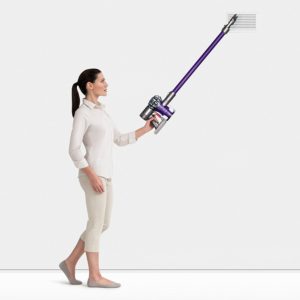
Max power mode, oddly enough, only dropped from 8 minutes in the V8 to 6 in the V6. However, we realized why when we compared both using the same cleaning heads. The V8 is significantly stronger than the V6. This was the second difference: suction. While the V8 generates up to 115 airwatts, the V6, like the V7 generation, tops out at 100 airwatts. In real world use, this meant being able to pick up a bedroom-full of Golden Retriever hair in 10 minutes with the V8 compared to 12 minutes with the V6. And if we were using the motorized heads, we’d still have 15 minutes to go in the V8 while we’d be out of business for another 3.5 hours (the recharge time) with the V6.
Interestingly, Dyson’s flagship handheld, the V7 Car+Boat, feels just as powerful as the V6 Animal when using the same cleaning tool (e.g., the mini motorized brush). It makes sense since they both have the same 100 airwatt suction rating.
Third, you get whole machine HEPA filtration with the V8 and nothing with the V6. Well, you get some filtering, but it’s definitely not HEPA. And if you have allergies or share a home with someone who does, a thorough filtration system can go a long way toward mitigating your symptoms.
Aside from these differences, the only other meaningful one was weight: the V6 tips the scales at 5 pounds compared to the V8 at 5.6. Practically speaking, the difference isn’t noticeable unless you’re holding one in each hand, which would be odd.
How well will the Dyson V6 Animal clean up after kids, pets, and spouses?
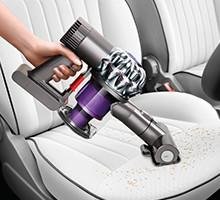
When choosing a cordless or stick vacuum, you’ve got to go into it with realistic expectations. You’re not going to get a full-sized upright cleaning experience as if you’d bought the Ball Animal 2, and you’re certainly not going to breeze through high-pile carpets as if you’d bought a Miele C1 Cat & Dog or Electro+. Dysons are amazing machines, but they can’t defeat the rules of physics.
That said, we expected the V6 Animal to effectively clean dust, dirt, pet hair, and endless amounts of food and grime from bare surfaces like counter tops and hardwood floors without breaking a sweat, and it did. We wanted it to tackle low-pile carpets, car seats, couches, and the insides of our minivans, cars, and SUVs without a struggle, and it did.
While we’d have liked to have seen significantly more battery life after having been spoiled by the V8, we’ll grudgingly admit that 20 minutes was enough to get a good cleaning session in as long as we didn’t spend too much time fussing about removing every last speck of dirt from every area in sight. Our main complaint at this level was the amount of time we needed to charge the battery, which is a running complaint of ours with Dyson; 3.5 hours is rather long for a vacuum that’s sold so heavily on convenience. When a basic robotic vacuum like the Shark 750 or 720 will recharge itself in 2-3 hours, we know the technology’s there, and we’d like Dyson to start using it.
Why buy the Dyson V6 Animal?
Overall, our feelings about the V6 Animal are mixed. If it existed in a world without the V8 Animal, we’d be thrilled. It’s easy to use, light weight, ergonomic, and offers enough power to do a satisfying, if not complete, cleaning job. But when we know the V8 Animal is readily available and comparable in price, and offers literally twice the battery life and a significant boost in suction, in addition to HEPA filtration, it’s hard to recommend the V6 over the V8. Both are great vacuums overall, but one provides a lot more value in our books.
![]() You can buy the Dyson V8 Animal vacuum here on Amazon. If you don’t want the battery, suction, or HEPA upgrades, you can buy the V6 Animal here instead.
You can buy the Dyson V8 Animal vacuum here on Amazon. If you don’t want the battery, suction, or HEPA upgrades, you can buy the V6 Animal here instead.
![]() Canadians can buy the Dyson V8 Animal vacuum here on Amazon or save some money with the V6 Animal here instead.
Canadians can buy the Dyson V8 Animal vacuum here on Amazon or save some money with the V6 Animal here instead.
 If you find our research on PMC helpful, you can follow our efforts to keep maniacally reviewing home cleaning tools by shopping through our links above. We promise to keep fighting the good fight against every horror children, animals, and grown, yet messy humans can inflict upon a clean home.
If you find our research on PMC helpful, you can follow our efforts to keep maniacally reviewing home cleaning tools by shopping through our links above. We promise to keep fighting the good fight against every horror children, animals, and grown, yet messy humans can inflict upon a clean home.

